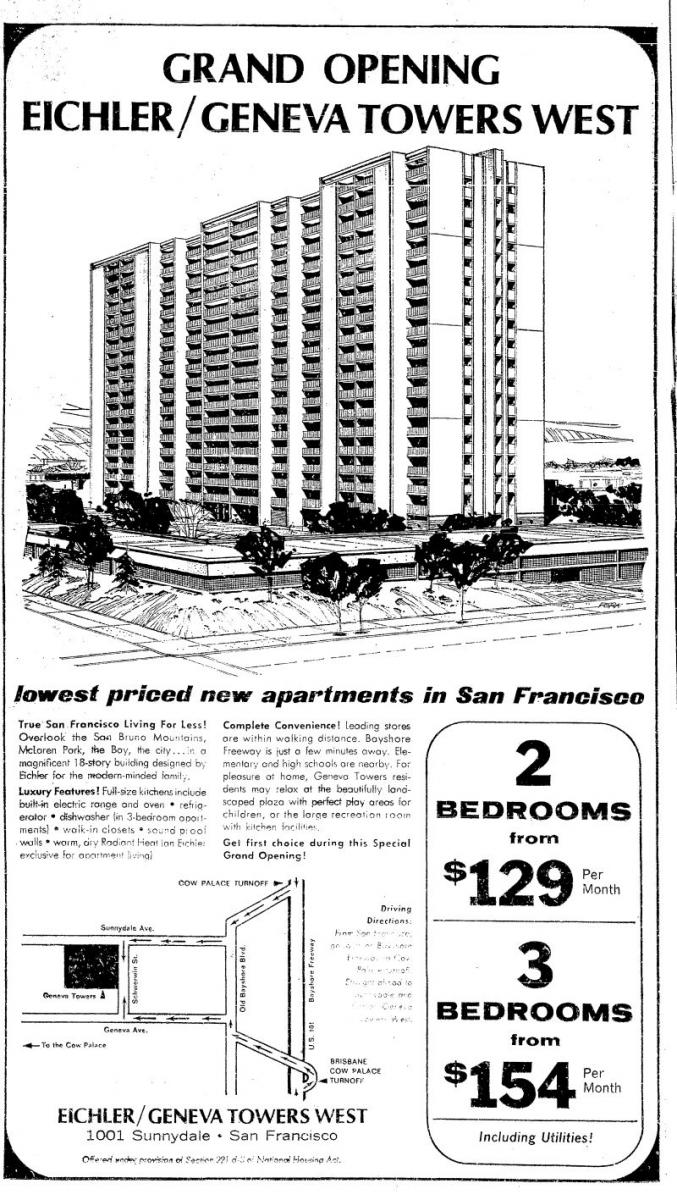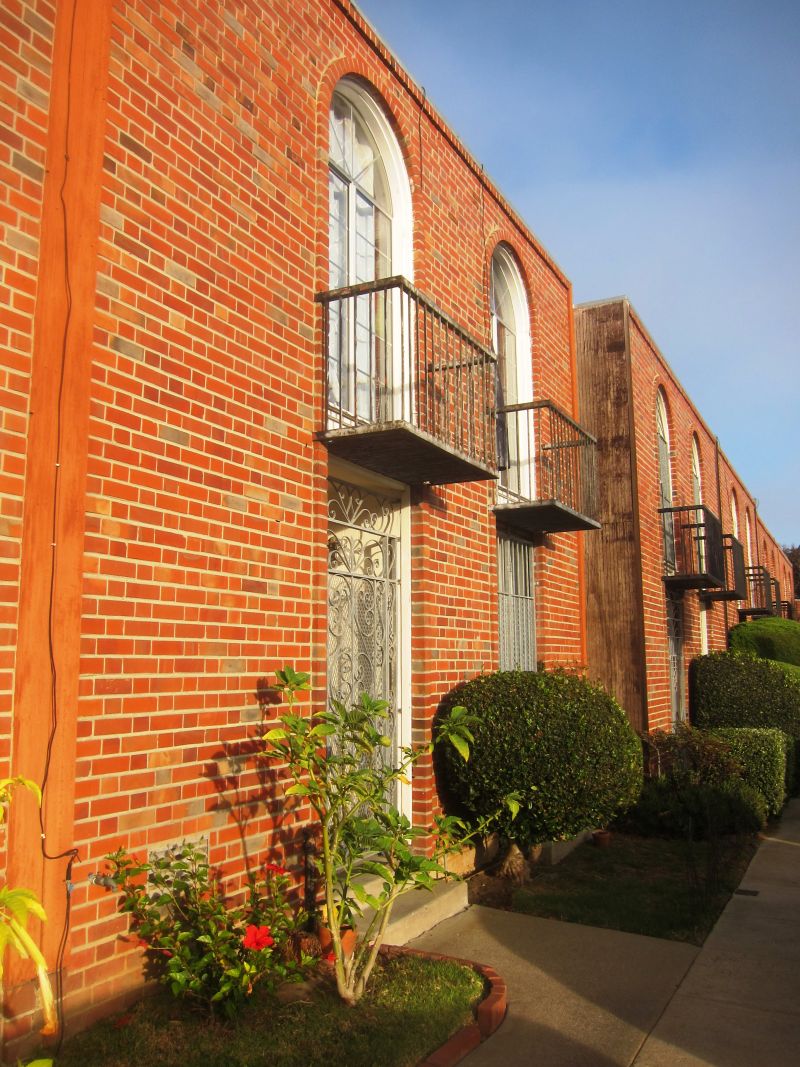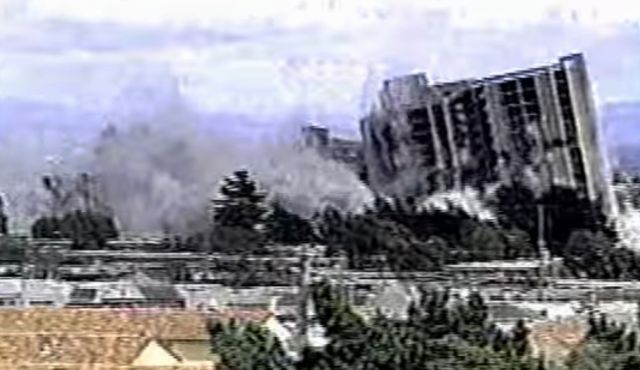
The Biggest Eichler Teardown Ever
 |
|
|
Today, Eichler teardowns are in the news, with neighbors in such Eichler-rich cities as Palo Alto and Sunnyvale seeking ways to prevent owners from replacing Eichler homes with new larger homes.
May 2018 will be the 20th anniversary of the largest Eichler teardown ever, that of the twin Geneva Towers in San Francisco, built as dream housing for the lower middle class, later to become known as “the ghetto in the sky.”
The implosion of these twin, 20-story towers (18 stories of apartments over parking) was the largest ever on the West Coast. Most people celebrated the coming down of the two 'notorious' buildings, which was watched by throngs both at the site and on television.
A few people mourned – those who had lived in the towers in their earlier days and had fond memories. But the mourners apparently did not include many Eichler fans.
The name of the building’s developer, Joe Eichler, was absent from press accounts, as it had been from press accounts going back to the mid 1970s that tracked the gradual decline of life in the apartments.
 |
|
|
As early as 1974 – the year Joe Eichler died (he had given up ownership of the towers in the mid 1960s) – the Towers were described as “troubled,” with the Tower Tenants Association and All People’s Coalition fighting with the owner to “make every effort to keep the 20-story building’s balky elevators running,” according to the San Francisco Chronicle.
By the 1980s problems were worse than bad elevators, with open drug dealing in the hallways, break-ins and robberies, and, one year, seven murders in and around the towers.
The Eichler Network did cover the destruction of the towers in 1998 with a feature article, and it is worth considering the towers again on the 20th anniversary of their destruction for what the tale says about Eichler’s socially conscious move into city high-rise living, and how good intentions can lead to disasters.
Eichler understood that housing was needed within cities, as well as in the suburbs (where he built most of his homes), and for people of all income levels and desires. He was building at a time when federal and city officials were willing to work with, and finance, builders of homes for low-income people, and for housing that served both low- and moderate-income residents.
When Eichler Homes announced in June 1964 that 'Eichler Geneva Towers' would be built three blocks from the Cow Palace in San Francisco’s southerly Visitacion Valley neighborhood, Eichler had already developed a middle-income townhouse development alongside the towers site.
Geneva Terrace, with 189 units, had been designed for middle-class dwellers by architect Claude Oakland.
The Towers would have “occupancy limited to middle income families.” A $19 million loan from the Federal Housing Authority provided financing.
 |
|
|
“All apartments above the second floor will have spectacular views of the San Bruno Mountains, McLaren Park, the Bay, and the City,” Eichler Homes promised. The towers would share a landscaped park and playground, include three- and four-bedroom apartments complete with radiant heat, have laundries on each floor – and provide childcare.
“This project will help in meeting one of San Francisco’s greatest needs,” mayor John Shelley said at the press conference, “medium income housing. I hope other builders will be as far-sighted as Mr. Eichler and come forward to assist in fulfilling the demand for such housing.”
The San Mateo Times reported on Eichler’s motive for the towers: “This unique housing project – the largest of its kind in the country – was planned by Joseph L. Eichler with human rather than financial profit in mind.”
The towers were built, the Chronicle reported, “under a special and little-known section of the Federal Housing Program designed to help provide housing for those people whose incomes are too high for public housing and too little for what is known as mass market housing.”
 |
|
|
Eichler, who also built residential towers atop Russian Hill and in the gritty Tenderloin, was focused on attracting people to live in San Francisco. A month before announcing Geneva Towers, he was named head of a Chamber of Commerce committee formed “to promote the advantages of living in the increasing number of high-rise dwellings in San Francisco.”
Interestingly – indeed, tellingly – Eichler began building Geneva Towers even as the city was awash with vacant apartments. As the Chronicle reported on May 31, 1964:
“It has been estimated that from 3,000 to 4,000 of the 10,000 high-rise apartments, cooperatives and condominium units now ready for occupancy in the city are vacant.”
Still, Joe apparently thought he could do well with Geneva Towers by appealing to “people whose incomes are too high for them to be eligible for low-income public housing units, yet who cannot afford the rent on privately-owned units they would like to have,” he told the Chronicle in May 1965.
Eichler also intended his apartments to be the lowest priced in the city.
Already Eichler was in trouble with the project. In fact, he had asked the city to take ownership – so “elimination of the taxes could permit considerably lower rents.”
The city considered this – and also considered turning the Towers into subsidized housing under the city’s Housing Authority.
 |
|
|
Joe said no. One of his concerns was that this would harm his customers who were living next door at his Geneva Terrace development. “I have a lot of houses I’ve built around there,” Joe told the Chron, “and I’d have to consider the effect on those houses, and on the people who bought them.”
Joe was prescient, as residents of Geneva Terrace watched over the years as their neighborhood deteriorated and became crime-ridden, as Geneva Towers (and the nearby Sunnydale housing project) fell into poverty.
“By the time HUD took over in 1991,” the Chronicle wrote, referring to HUD’s foreclosure of the project, “Geneva Towers was a den of dope dealing and violence.”
But Vernon Long, reflecting on the implosion, recalled the good times in the 1970s when he lived in the towers. “It was a great place to live,” he told a reporter. "I have good memories there. My children were raised in there.”
- ‹ previous
- 563 of 677
- next ›



